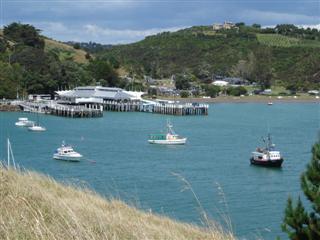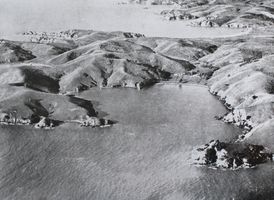Please show your support of Waihekepedia by adding a link to us from your web site. Waihekepedia T Shirts now available at the Ostend Market
Matiatia
Matiatia
About Matiatia
Matiatia Bay is located at the western end of Waiheke Island and features the Matiatia Ferry Terminal which is the arrival point for the passenger ferries from downtown Auckland.
History
Several wahi tapu along the foreshore, each with human remains confirmed by ground-penetrating radar, attest to the use of Matiatia by Maori in pre-European days.
The site of Mokemoke Pa on the northern headlands is clearly visible. In 1840 its inhabitants are said to have moved to the Matiatia flat, neary to their gardens.
Island historian Paul Monin, in a series in Gulf News, said:
- "People from two very different descent lines settled at Matiatia in the late 1830s: tangata whenua and Taranaki.
- "Wiremu Keepa, brother of Wiremu Hoete of Te Huruhi, led a whanau of Ngati Hura of Ngati Paoa. Ropata Te Roa led a few Taranaki former slaves whom Hoete’s wife had brought back to Waiheke.
- "Ropata Te Roa was an exceptionally productive resident of Matiatia until his sudden death in July 1894. The driving force behind the bay’s farming ventures, he also conveyed much of its produce to Auckland as owner-operator of five sailing vessels at various times. He is buried in the picket fence enclosure, next to the karaka tree on the foreshore."
Here you can read Paul's piece on the history of the island's gateway bay in full. Later the land at Matiatia was owned by the Alison family.
Local legend has it that Hollywood belle Vivienne Leigh visited Matiatia on board the mayor of Auckland's yacht.
The controversy
Auckland City acknowledges on its own web page for Matiatia that the gateway bay "should be home to a world-class sustainable development". However, since Waitemata Infrastructure Ltd launched its plans for a $35 million commercial and residential development in 2000, proposals for developing the bay have been dogged with controversy. The three key directors of WIL were Stephen Norrie, Graham Jull and Bill Birnie.
WIL, who had bought the land for $3.5 million, proposed a conference centre, apartments and retail complex. The proposal was championed by Auckland mayor John Banks, who described it as moving Auckland forward. But opposition from Waiheke residents saw the formation of the Community and People of Waiheke (CAPOW), which before long had 1500 members. High profile residents like former newsreader John Hawkesby became the public face of the campaign against WIL's proposal. A fundraising concert, dubbed Love Matiatia, was held at the home of Claude and Gabrielle Lewenz. Among high profile performers were actor Michael Hirst and opera singer Helen Medlyn. About $40,000 was raised, money allowed CAPOW to engage barrister Richard Brabant for court action that reached the High Court.
In the last days of the campaign for the 2003 local body elections, it became clear Mr Banks was in business elsewhere with the investors, although he strongly rejected allegations of a conflict of interest. Mr Banks was succeeded as mayor of Auckland by breakfast cereal businessman Dick Hubbard, who had promised publicly to support islanders in the struggle for Matiatia.
In 2005 Mr Hubbard, by his own admission, made a lonely walk to the offices of WIL with a proposal that Auckland City should buy the strategic Harbourmasters property from the developers. After some negotiation, a deal was struck. Auckland City ratepayers would pay $12.5m for the company itself, turning WIL into a council-controlled organisation.
Current development plans from Auckland City Council
Auckland City now has plans to keep ownership of the property and lease some of it to developers for a return of $7.5 million.
The following is from the council's website:
- "Matiatia, Waiheke Island, New Zealand is an important strategic asset that needs to be developed in a way that is inspirational and extraordinary.
- "The landscape of the 4.25 hectare Matiatia Valley serves as the gateway to Waiheke Island and should be home to a world-class sustainable development.
- "In a bid to see such a development on site, Auckland City launched an international search for ideas to develop Matiatia. Cash prizes were offered for finalists and the designer of the final concept chosen by the council will have the opportunity to help develop their design on the site.
- "To guide designers, the council engaged a working party to develop a design brief for the site. The working party was made up of
- architects
- designers
- property developers
- councillors and
- community representatives.
- "The brief, 'A vision for Matiatia', incorporated both the design principles established by the Waiheke community and the elements Auckland City wants to see included in any development.
- "'A Vision for Matiatia' was a two stage process.
- "The first stage was open to any interested party and 75 designs were submitted. These entries went on public display and about 400 visitors completed a feedback form. An assessment panel (made up of built environment professionals and community representatives) selected five finalists from these 75 and further refined the design brief taking into account the public feedback. These finalists then submitted more detailed designs for stage two, which were also displayed for public feedback. The assessment panel then met again to select a preferred concept .
- "Design 201 was recommended by the assessors to the committee as the preferred concept.
- "This concept will be further developed by a working party, in association with the preferred design team and passed to the council's Property Enteprise Board for implementation."

